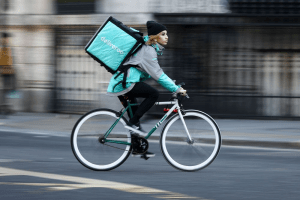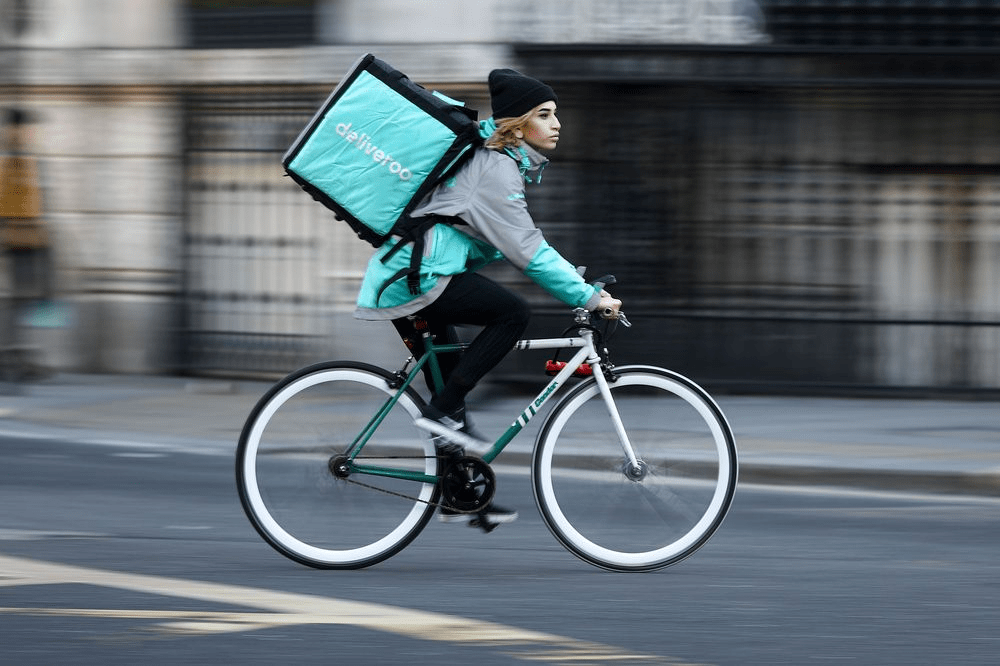Headquartered in London, Deliveroo is a British start-up success story that offers fast and reliable food delivery which the customer can track on their phone. Operating in 12 different countries, 150 cities and with a fleet of 35000 drivers, Deliveroo is convinced that great food shouldn’t cost the earth. However, given the scale of its operations, how to manage sustainability within the complex network of restaurants, drivers and customers?
While the business model has proven to be very successful in cities around the world and many companies have shown spectacular growth in recent years, climate change may prove to be a game changer for this industry. For all the good these companies have done in terms of making people’s lives easier, enriching them by introducing them to more diverse foods and allowing small business owners to reach a larger public, this has come with considerable externalities. Increased use of packaging materials, food waste as a result of over ordering and millions of fossil-fuel powered miles by delivery drivers all add to the negative environmental impact of this industry. Climate change, and the shared responsibility that it brings to consumers, businesses and governments, may considerably affect the future of this industry. Confronted with the negative impact of all their “convenience”-choices, consumers may decide to order less, new competitors may offer environmentally friendlier alternatives and governments may pose increased regulation that further challenge this industry that is already struggling for profitability. On the flipside, this challenge also represents a business opportunity for the competitor in this industry that effectively sets up its business model in a resilient way, which in case of increased environmental scrutiny pays of as a competitive advantage.
For Deliveroo sustainable growth comes from the little wins that add up to a major plan. During the last years, they have been launching several initiatives in order to minimize the impact of their operations across the food delivery value chain:
Sourcing:
In November of 2018, Deliveroo committed to removing all shark fin dishes from its platform. As a result, 150 shark fin dishes from 34 restaurants were removed from the app. Beyond taking shark fin and any related shark fin products out of its physical and digital menus, Deliveroo is actively controlling the menu that the restaurants are offering in their platforms.
Packaging:
Deliveroo is the first food delivery company that introduced an ‘opt in for cutlery’ feature. The platform requires the customer to actively select whether they want to receive cutlery with their order. This starts from the assumption that 85% of the time customers order food for home or the office, where they already have their own cutlery, so most of the time forks and knives results in plastic waste. From its introduction in June 2018, this “small” nudge has already reduced plastic waste by 65% and brought an economic advantages to the partner restaurants.
Deliveroo promotes the use of biodegradable straws and eco friendly packaging by providing free samples to their restaurants, and getting them available on their online store. Now everybody can buy the entire eco-packaging line on the Deliveroo Packaging Store at competitive prices, having more access to biodegradable, compostable and recyclable packaging. From the packaging standpoint, the company is also actively cooperating with startups and universities (HEC and INSEAD), to develop smart systems to address the challenges that such a varius offer of dishes implies.
Distribution:
Logistics optimization is at the heart of what Deliveroo does. The app uses an algorithm to ensure efficient delivery: delivery radius is limited to maintain this level of efficiency, and to encourage people to order from restaurants that are local to them.
Consumption:
The company promotes sustainable eating by giving special offers and discounts for restaurants with “green” menus and plant-based proteins. From May 21 of 2019 onwards, Deliveroo is partnering exclusively with Impossible Foods to offer dishes and meals made from its plant-based products.

Recycling:
To help our restaurant partners reduce their use of takeaway packaging, Deliveroo has partnered with RETURNR in Australia, introducing the option to order food in reusable containers. RETURNR is an environmental initiative that replaces single use takeaway packaging with equivalent reusable solutions, giving customers the opportunity to have their dish delivered in a reusable bowl. When customers place their order, they will then have the option to select “RETURNR” – if they opt in for this service, they pay an additional $6 on the app to have their dish delivered in a reusable container. Customers can return the bowl to any RETURNR supported restaurant to get their $6 back.

However, this is a long journey and there are many steps that might be taken additionally in the future. These could include the following.
Deliveroo is collaborating with the Word Wide Fund (WWF) in an sustainable initiative consisting on categorizing their suppliers and restaurants using scoreboards to improve their sourcing. Restaurants are rated based on three major indicators: raw materials sources (i.e. plant-based proteins, organic crops), food waste management and menu selection. This categorization can be used for two purposes.
Firstly, Deliveroo could use it to incentivize the restaurants to become more sustainable, for example by paying higher commissions to those with a lower impact on the environment. A step in this direction is the pledge to remove all shark fin dishes from their menus in Singapore, as was already mentioned before.
A second purpose is to use the restaurant categorization to help customers choose the most environmentally-friendly meal, in terms of ingredients but also distance from the restaurant to their home. For example, the customer could be shown a “sustainability score” for their order, which is higher when they choose plant-based meals from a restaurant close to them, hence minimizing the driving distance to deliver the food. Deliveroo could go further in promoting environmentally-friendly foods by tweaking their algorithm to show those dishes on top in their app. However, this could be controversial as it might be perceived as too intrusive.
Another possible measure to reduce Deliveroo’s environmental impact could be to incentivize drivers to choose a more sustainable transportation method. For example, riders could receives bonuses when they choose to deliver with an electric vehicle or traditional bike over a fuel-powered scooter. This will help to reduce Deliveroo’s footprint, reduce noise in cities and might contribute to an improvement in health of riders.
In the UK, Deliveroo is already running a pilot in which riders can rent an e-bike or e-scooter at a reduced rate to replace their motorbike, for example if they’re not able (or willing) to purchase the vehicle upfront. In smaller cities with suitable climates, Deliveroo could consider to extend these pilots to normal bikes as well.

In any case, be it for those initiatives that Deliveroo is already deploying, or for any of the additional opportunities described above, they would do well to systematically measure their impact. Just like management needs financial and organizational KPIs to effectively steer an organization, they need measurements on the impact that various initiatives are realizing to make sure both financial and organizational resources are used towards environmental impact in the most effective way. Elevating these initiatives from a mere CSR initiative to one of the core elements of their business model allows them to prove to environmentally-conscious consumers and government regulators exactly how they are leading in their industry.
Charlotte, Cristina, Sara & Jelle

+1 on encouraging disruptive businesses to be more sustainable!
Having said that, it will be really interesting to explore the sustainability score between delivery, food preparation at home, and transporting the consumers to the restaurant. On the surface level, there might be a case that it is more sustainable to transport packed food, compared to transporting a family of 5 to the restaurant. At the same time, it will be interesting to understand the yield of raw food to consumption between restaurants (which might be more specialised) vs those at home (where food may be wasted because of poor inventory management).
What I think it’s interesting about this business is that it has influence over several stages of the operational process. From the way the food is cooked in the restaurants to the way customers eat, they have a major control over all the process if they’re successfully able to scale and attract the increasing “green” consumers that believe environmental sustainability is an important goal of companies. If they achieve this success they have the potential to influence, for example, waste generation in restaurants, source of the vegetables and meat used (pressuring restaurants to work with low impact suppliers) or by inducing the customer to use less packaging or fewer single use plastic cutlery, which can have a great impact in the environment. The major question now is how to compete with other food delivery services that can probably offer cheaper service in a market where price is generally the primary drive for customer choice.
Hi guys, I really like the way a lot of the sustainability angle here is about nudging the consumer! These sorts of platform businesses build their brand round consumer choice, so offering people the choice to be more environmentally friendly (and encouraging them to move towards it) is very much in line with their message.
It would be interesting to see what the platforms’ level of commitment is to things like limiting delivery radius if they face competition from a new entrant without this feature. I wonder if they have priced in a potential loss of sales from limiting consumer choice here.
Great article to demonstrate that a lot of times, new business models may trigger additional sustainability issues. For example, there were several debates that the presence of ride-hailing companies in Indonesia incentivized customers not to take mass public transportation and even resulted in additional traffic jams.
Thank you for your insightful article !
I didn’t know Deliveroo was so committed to sustainable development and I really appreciate that you covered this environmental aspect.
Sustainability also includes social responsibility. I wonder if Deliveroo also works on improving the deliverers’ quality of life. Those jobs are usually precarious. Since Deliveroo asks for each deliverer to be an independent worker, the company doesn’t have to compensate for their holidays, medical expenses, retirement plan… and can easily modify their earnings.
In some countries, deliverers start to gather and strike for more job security. This could impact their business plan.
Thank you for your excellent post, which does a great job of examining the sustainability issues that impact Deliveroo across its merchant, customer, and delivery operations.
One issue that I think has not been explored here is the rise of take-out only restaurants as delivery becomes more affordable and accessible. These “dark restaurants” exist only as kitchens and can be as compact as a shipping container. They present a low-risk way for owners to experiment with new restaurant concepts and for restaurants to open with low fixed investments.
From an environmental standpoint, dark restaurants also require less energy, space, and materials because they have no dining area. If services like Deliveroo continue to grow in popularity and efficacy, in-restaurant dining could become less common and the carbon footprint of restaurants could shrink. Of course, other issues addressed above like food transportation, packaging, etc. would all see a a concomitant uptick that would likely offset any positive gain from decreased in-restaurant dining .
Thanks for your great post!
This article makes me better understand food delivery startup’s current actions for sustainability. I’m surprised by the fact that Deliveroo is trying to affect the restaurant side by using scoreboards to improve their sourcing. Food delivery provider is difficult to differentiate from other competitors in terms of service and quality, but I believe that these sustainable actions can strengthen its competitiveness.
Another big issue of sustainability at the food delivery industry is the employee’s, particularly deliverers, empowerment. Their wages tend to be low and working condition is also not good.